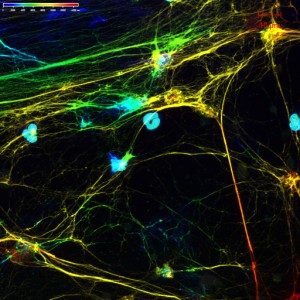
Neutrophil extracellular traps (NETs) are web-like structures that immune cells called neutrophils use to ensnare and kill microbes such as bacteria or fungi. Normally, NETs are released in response to invading pathogens, but the traps have also been associated with autoimmune diseases such as systemic lupus erythematosus (SLE). Some evidence suggests that NETs, which contain an individual’s own cellular proteins and DNA, can trigger an immune reaction to these "self" components and promote autoimmunity.
Now, researchers led by Mariana J. Kaplan, M.D., chief of the Systemic Autoimmunity Branch in the Intramural Research Program at the National Institute of Arthritis and Musculoskeletal and Skin Diseases (NIAMS), and Keith B. Elkon, M.D., head of the division of rheumatology at the University of Washington, have uncovered a role for mitochondria, the cell’s power producers, in the release of NETs and the development of autoimmune disease. In particular, mitochondrial reactive oxygen species (ROS), which are normal byproducts of oxygen metabolism in mitochondria, and oxidized mitochondrial DNA appear to be important players. The study was published in Nature Medicine.
Their research showed that mitochondrial ROS play a key role in driving the release of NETs by neutrophils in both healthy individuals and people with SLE, but especially among those with SLE. The study also revealed that in laboratory-grown human neutrophils, as well as in mice, oxidized DNA from mitochondria stimulates a signaling molecule called interferon. Activation of interferon helps trigger the immune system and has been linked to SLE.
When the researchers blocked mitochondrial ROS in SLE-prone mice using a ROS inhibitor, there was a decrease in NET release by the mice’s neutrophils. The mice also showed reduced signaling through the interferon pathway and fewer signs of autoimmune disease.
Together, the findings revealed that mitochondrial ROS play a role in NET formation that was previously unknown. The results also suggest that ROS and oxidized DNA from mitochondria contribute to initiating or perpetuating SLE, and possibly other autoimmune diseases.
Several mitochondrial ROS inhibitors are currently being tested in clinical trials for other diseases, such as liver disease and Duchenne muscular dystrophy. These new results provide a rationale for testing them in the context of autoimmune diseases, as well.
This work was supported by the NIAMS intramural program under project number ZIA AR041199. Support was also provided by the Washington Research Foundation, Leap for Lupus, the Wenner-Gren Foundation, and the foundation BLANCEFLOR Boncompagni-Ludovisi nee Bildt.
Lood C, Blanco LP, Purmalek MM, Carmona-Rivera C, DeRavin SS, Smith CK, Malech HL, Ledbetter JA, Elkon KB, Kaplan MJ. Neutrophil Extracellular Traps Enriched in Oxidized Mitochondrial DNA are Interferogenic and Contribute to Lupus-Like Disease. Nat Med. 2016 Jan 18. doi: 10.1038/nm.4027. [Epub ahead of print] PMID: 26779811
The mission of the NIAMS, a part of the U.S. Department of Health and Human Services' National Institutes of Health, is to support research into the causes, treatment and prevention of arthritis and musculoskeletal and skin diseases; the training of basic and clinical scientists to carry out this research; and the dissemination of information on research progress in these diseases. For more information about the NIAMS, call the information clearinghouse at (301) 495-4484 or (877) 22-NIAMS (free call) or visit the NIAMS website at https://www.niams.nih.gov.
